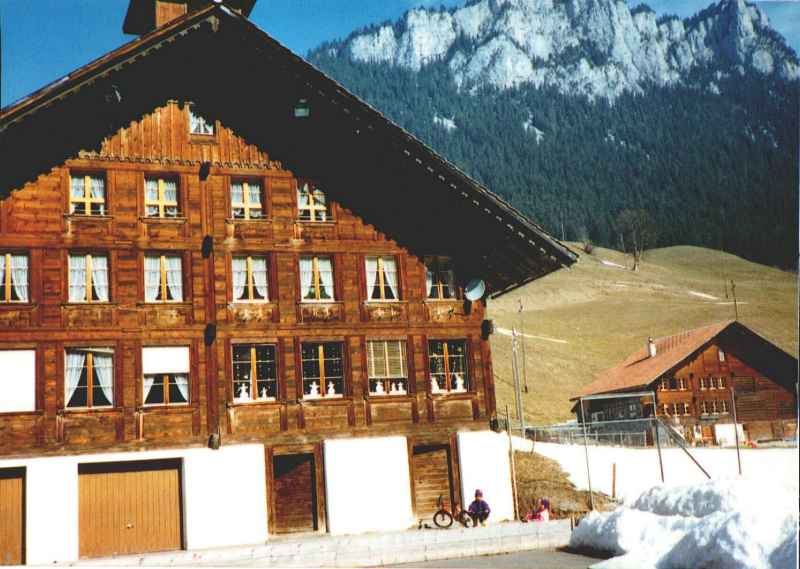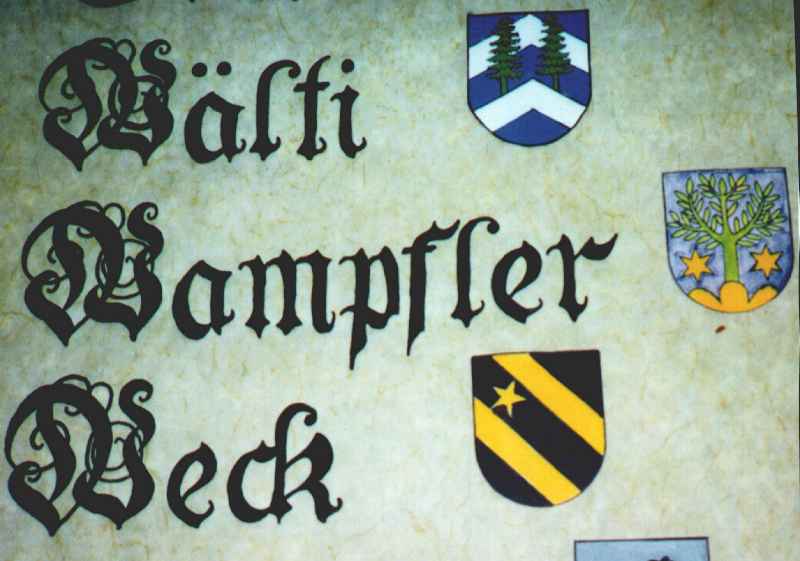
The Wampler/Wampfler Family Name, Then and Now
by John E. Wampler
last revised 2/12/'04
 |
The Wampler/Wampfler Family Name, Then and Now
|
Section 1.1
last revised 2/12/'04 |
"Wampfler is a very old name. (It) comes from the Simmental, Bernese uplands (Berner Oberland). There is a little village today in the Diemtigtal (a little valley b(e)side the Simmental) This village is named Wampflen. Today (there is) an old mill and a beautiful house . The meaning of the word Wampfler is today clearly. Wampflen means 'among the Wandfluh'. The residents lived below a steep rock face. Wandfluh then changed to Wampflen and then to Wampfler."
 |
| Fred Wampler (1986) also mentions Wampflen in the Bern Canton in Switzerland near the village of Diemtigen ( see Michael Wampler's photo-album). He has some pictures of the small village indicating that it had four houses (c. 1983). He says that near Wampflen is a "gigantic rising wall of rock". He found a mention of Wampflen as a place name as early as 1600 in a christening record in Diemtigen. The rock wall seen here is behind the school building as described in Fred Wampler's book (1986). The land to the right and behind the school is said to have been Wampfler land. Picture from Dr. John M. Wampler." |
As far as I know, the name "Wampfler" is a location name, corresponding to the landscape topography: In the valley of Diemtigen, there is a place called Wampflen, where the small river seems to make a little step down (as can be guessed from the maps). In the municipality "Meilen" in the canton of Zurich at the lake of Zurich, there is a rivulet, which has a jump and this place is also called "Wampflen". A local teacher had the opinion, that this name originates from the term "Wandfluh", which means something like mass of rocks or a wall of rocks.
In a book I found another possible explanation: the alemannic or germanic terms "wam", "wem" or "wim" seem to design(ate) some sort of flowing water. In Austria for example, there is for example a city called "Wampersdorf", whose name should originate from this root "wam". The fact, that the (two) Wampflen have to do with rivulets could be a point for this argument.
 |
| The Coat-of-Arms on the wall of the Lenk Public Building. Photo by Dr. John M. Wampler. See also the Winter 1999/2000 Newsletter. |
With a 2000 estimated population of about 7 million, assuming each listing represents an average of 2 people with the Wampfler surname, the frequency must be a bit less than 0.01% in Switzerland. This would make Wampfler somewhat more prevalent in Switzerland than is Wampler in the USA (0.003% as discussed below).
A search of the Bas-Rhin Department of France in 2001 using http://www.epita.fr:5000/11/english.html the French Electronic Phonebook on the Web gave 13 listings for the Wampfler surname. A search of http://www.pagesjaunes.fr (2004) gave 12 listing of Wampfler in Alsace. This is by far the most listings of any region with a total found for France of 29. The Yahoo Factbook gives the population of France at 59 million (estimated for July 2000) making the frequency of the Wampfler surname something like 0.0001% using the assumption of 2 people for every phone listing.
The German White Pages search at http://www.teleauskunft.de/ gave 25 listings, but only 12 were individuals (the rest being for the large multinational firm, Wampfler AG). Four listings for Wampler were also found, each with seemingly non-germanic given names. With a German population around 82 million, the Wampfler/Wampler surname occurs with a very low frequency in Germany (<0.00005%).
Of the various spellings, Wampler is by far the most predominant in America. The white pages survey map for the "Wampler" surname generated by Hamrick Software shows the name most common in Virginia and Indiana (1:1000), then Missouri and Tennessee followed by Ohio, Arkansas, Kansas, North Dekota and Oregon. Using the surname search of the U.S. Census Bureau, the name Wampler is ranked 4,259 th in frequency out of 88,799 names (or 0.003% of the surnames listed). None of the other variants are listed.
Yahoo White Pages and E-mail searches for the variants of the surname list the following numbers of listings (1996):
Variant...White Pages....e-mail
Wampler 4058 133
Wampfler 79 5
Wompler 3 0
Wambler 0 0
Wamfler 0 0
Wombler 0 0
T. Cushing (1975) "A Genealogical and Biographical History of Allegheny County, Pennsylvania," Genealogical Publishing Co., Inc., Baltimore, Md.
Niklaus Siegenthaler (1937), "Bilder aus der Geschichte de Obersimmentals," Verlag E. Blessing, Zweisimmen.
Hans Sommer (1944), Kleine Namekunde, Verlag Paul Haupt, Bern.
Ralph B. Strassburger (1966), "Pennsylvania German Pioneers," Genealogical Publishing Co., Baltimore (3 volumes).
Fred B. Wampler (1986), "Wampfler (Wampler) Family History, The 1500's-1700's", privately published, Santa Fe, New Mexico.
Michael Tepper (1982), "Passenger Arrivals at the Port of Baltimore, 1820-1834," Genealogical Publishing Co., Baltimore.
Michael Tepper (1986), "Passenger Arrivals at the Port of Philadelphia, 1800-1819," Genealogical Publishing Co., Baltimore.
Barbara S. Wampler (1977), "Letter to Don, February 24, 1977" from the files of Terry L. Wampler
Barbara S. Wampler (1979), "Wampler Ancestors and Descendents in America," Newsletter #6, Barbara S. Wampler, 310 Thayer Ave., Joliet, IL 60432
Hansruedi Wampfler (Switzerland), text of e-mail message to John E. Wampler (wampler@bchiris.bmb.uga.edu).
Robert Wampfler (Switzerland), text of e-mail message to Ivan Wampfler (71324.544@compuserve.com).